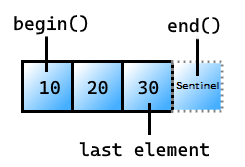lazy_split_view class (C++ Standard Library)
Splits a range into subranges based on a delimiter. The delimiter can be a single element or a view of elements. The delimiter isn't part of the resulting subranges.
The primary differences between a split_view and a lazy_split_view are:
| View | Can split a const range |
range type |
|---|---|---|
split_view |
no | Supports forward_range or higher. |
lazy_split_view |
yes | Supports input_range or higher. |
What makes a lazy_split_view "lazy" is that it doesn't lookahead for the next delimiter. That means it can support input_range whereas split_view requires at least forward_range. This is because input_range is single-pass whereas forward_range allows multi-pass iteration.
Prefer split_view because it's more efficient--unless you must split a range that is const. Regarding performance, split_view is more efficient.
A lazy_split_view has less efficient iterator increment and comparison than split_view, but is still O(1). A split_view has better performance when the distance between delimiters is small enough for subranges to fit in the CPU cache, in which case the delimiter lookahead effectively pre-caches the next subrange.
Syntax
template<input_range V, forward_range Pattern>
requires view<V> && view<Pattern> &&
indirectly_comparable<iterator_t<V>, iterator_t<Pattern>, ranges::equal_to> &&
(forward_range<V> || tiny_range<Pattern>)
class lazy_split_view : public view_interface<lazy_split_view<V, Pattern>>
Template parameters
Pattern
The type of the view that specifies a delimiter sequence.
The (forward_range<V> || tiny-range <Pattern>) requirement means that when the underlying range isn't forward_range, the delimiter must be a tiny_range. A tiny_range is a range with static extent whose size is 0 or 1. tiny_range<T> requires sized_range<T>, and T::size() must be a constant-expression that's less than or equal to 1.
V
The type of the underlying view.
Characteristics
For a description of the following entries, see View class characteristics
Range adaptor: lazy_split
Underlying range: must satisfy input_range or higher
View iterator category: same as the underlying range
Element type: collection of range_reference_t<V>
Sized: no
Common range: Yes when the underlying range is both forward_range and common.
Borrowed range: no
Is const-iterable: only if the underlying range satisfies forward_range and is const-iterable
Members
| Member functions | Description |
|---|---|
| Constructors | Construct the view. |
baseC++20 |
Get the underlying range. |
beginC++20 |
Get an iterator to the first element in the view. |
endC++20 |
Get the sentinel at the end of the view. |
Inherited from view_interface |
Description |
emptyC++20 |
Test whether the view is empty. |
frontC++20 |
Get the first element. |
operator boolC++20 |
Test whether the view isn't empty. |
Requirements
Header: <ranges> (since C++20)
Namespace: std::ranges
Compiler Option: /std:c++20 or later is required.
Constructors
Construct an instance of a lazy_split_view
1) lazy_split_view() = default;
2) constexpr lazy_split_view(V base, Pattern pattern);
3) template<input_range R> requires constructible_from<V, views::all_t<R>> &&
constructible_from<Pattern, single_view<range_value_t<R>>>
constexpr lazy_split_view(R&& rg, range_value_t<R> e);
Template parameters
Pattern
The type of the delimiter.
R
The type of the range.
V
The type of the underlying view.
Parameters
e
A single element that identifies where to split the view. The element isn't part of the resulting subranges.
base
The underlying view.
pattern
The view of elements that identifies where to split the view. The view of elements isn't part of the resulting subranges.
rg
The range to split.
Return value
A lazy_split_view instance that contains one or more subranges.
Remarks
The best way to create a lazy_split_view is by using the views::lazy_split range adaptor. Range adaptors are the intended way to create view classes. The view types are only exposed in case you want to create your own custom view type.
1) Create a lazy_split_view that has no elements. The underlying view is default constructed. base() returns a copy of V().
2) Create a lazy_split_view by splitting the view using a delimiter sequence.
3) Create a lazy_split_view by splitting the view using a delimiter element.
Example: lazy_split_view
// requires /std:c++20 or later
#include <ranges>
#include <iostream>
#include <vector>
int main()
{
std::vector<int> rg{ 1, 2, 3, 1, 2, 3, 4, 5, 6 };
// pipe syntax using range adaptor
for (const auto& subrange : rg | std::views::split(3))
{
// Outputs:
// 1 2
// 1 2
// 4 5 6
for (const auto& elem : subrange)
{
std::cout << elem << ' ';
}
std::cout << '\n';
}
int delimiters[] = {2, 3};
for (auto splitRange : std::views::split(rg, delimiters)) // ctor syntax
{
// outputs 1 1 4 5 6
for (auto& i : splitRange)
{
std::cout << i << " ";
}
}
}
1 2
1 2
4 5 6
1 1 4 5 6
base
Gets a copy of the underlying view.
// Uses a copy constructor to return the underlying view
1) constexpr V base() const & requires std::copy_constructible<V>;
// Uses a move constructor to return the underlying view
2) constexpr V base() &&;
Parameters
None.
Returns
The underlying view.
begin
Get an iterator to the first element in the view.
constexpr auto begin();
constexpr auto begin() const requires forward_range<V> && forward_range<const V>
Parameters
None.
Return value
An iterator pointing at the first element in the view.

end
Get the sentinel at the end of the view.
1) constexpr auto end() const;
2) constexpr auto end() requires forward_range<V> && common_range<V>;
Parameters
None.
Return value
The sentinel that follows the last element in the view:

Remarks
2) The forward_range<V> requirement means that the view V has at least a forward iterator. For more information about range iterators, see View class characteristics. The common_range<V> requirement means that the view V has identical iterator and sentinel types.
See also
<ranges>
lazy_split range adaptor
split_view class
view classes